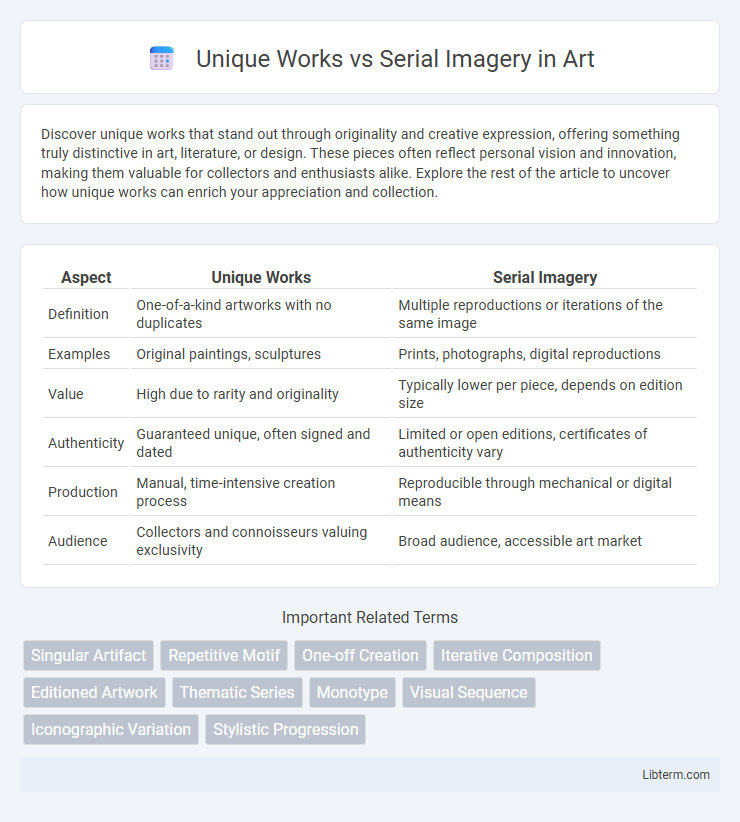Discover unique works that stand out through originality and creative expression, offering something truly distinctive in art, literature, or design. These pieces often reflect personal vision and innovation, making them valuable for collectors and enthusiasts alike. Explore the rest of the article to uncover how unique works can enrich your appreciation and collection.
Table of Comparison
| Aspect | Unique Works | Serial Imagery |
|---|---|---|
| Definition | One-of-a-kind artworks with no duplicates | Multiple reproductions or iterations of the same image |
| Examples | Original paintings, sculptures | Prints, photographs, digital reproductions |
| Value | High due to rarity and originality | Typically lower per piece, depends on edition size |
| Authenticity | Guaranteed unique, often signed and dated | Limited or open editions, certificates of authenticity vary |
| Production | Manual, time-intensive creation process | Reproducible through mechanical or digital means |
| Audience | Collectors and connoisseurs valuing exclusivity | Broad audience, accessible art market |
Defining Unique Works and Serial Imagery
Unique works are original pieces of art created as a single, distinct entity with no identical copies, emphasizing individuality and exclusivity. Serial imagery involves producing multiple iterations of the same image or concept, allowing variations in edition size, technique, or presentation while maintaining a core visual identity. Both approaches significantly impact the value, perception, and distribution of artworks within the art market and collector communities.
Historical Origins of Serial Imagery
Serial imagery traces its historical origins to early photographic experiments in the 19th century, notably Eadweard Muybridge's motion studies capturing sequential movement. Unlike unique works, which are singular creations emphasizing individual artistic expression, serial imagery consists of repeated or sequential images designed to explore time, motion, and narrative progression. These early serial images laid the groundwork for contemporary visual storytelling and conceptual art practices by emphasizing process and variation.
Key Characteristics of Unique Artworks
Unique artworks exhibit singularity through their one-of-a-kind creation, encompassing original materials, techniques, and artistic expressions that cannot be replicated exactly. These pieces often carry intrinsic authenticity, rarity, and substantial cultural or emotional value tied to the artist's individual craftsmanship. Collectors and museums prioritize unique works for their exclusivity, historical significance, and investment potential compared to serial imagery produced in multiples or prints.
Artistic Intent: Individuality vs Repetition
Unique works emphasize artistic intent through individuality, showcasing an artist's singular expression and creative exploration. Serial imagery explores repetition, where the artist intentionally plays with variations of the same subject to investigate subtle differences and thematic depth. This contrast highlights the conceptual focus on uniqueness versus the iterative process within artistic practice.
Techniques Used in Serial Imagery
Techniques used in serial imagery emphasize repetition and subtle variation to explore temporal change and narrative continuity within a single thematic framework. Artists employ methods such as sequential framing, slight compositional shifts, and gradual tonal adjustments to convey movement or transformation across multiple images. This approach contrasts with unique works, which prioritize singular, standalone expressions without iterative modification.
The Role of Variation in Serial Art
Variation in serial art transforms repetitive motifs into dynamic visual narratives, enhancing viewer engagement by introducing subtle or significant differences across images. Unique works within serial imagery challenge perceptions of originality and mass production, emphasizing the creative process through distinct alterations or thematic shifts. This interplay underscores the importance of nuanced change in serial art to balance uniformity with innovation, enriching both artistic expression and conceptual depth.
Notable Artists Exploring Serial Imagery
Notable artists such as Andy Warhol and Yayoi Kusama have significantly contributed to the exploration of serial imagery by producing repetitive patterns and multiple versions of similar works, challenging traditional notions of uniqueness in art. Warhol's silkscreen prints, like the iconic Marilyn Monroe series, emphasize mass production and consumer culture, while Kusama's installations utilize repetitive dots to evoke infinity and obsession. These approaches highlight the contrast between unique works and serial imagery, reflecting deeper themes of identity, reproduction, and perception in contemporary art.
Collectors’ Perspectives: Unique vs Serial Pieces
Collectors favor unique works for their exclusivity and potential to appreciate in value as one-of-a-kind assets, often perceiving them as more authentic and emotionally resonant. Serial imagery appeals to collectors seeking accessibility, consistency, and the opportunity to acquire multiple pieces within a series that share thematic or stylistic elements. The choice between unique and serial pieces hinges on individual collector priorities, such as investment potential, artistic significance, and personal connection to the artwork.
Impact on Visual Perception and Interpretation
Unique works create singular, unrepeatable visual experiences that encourage viewers to engage deeply with the artwork's distinct context and details, fostering a personal and contemplative interpretation. Serial imagery, by repeating motifs or variations, emphasizes patterns and continuity, which can influence perception by highlighting thematic evolution and inviting comparisons across iterations. This repetition can either reinforce a concept or challenge the viewer's understanding through subtle or dramatic changes, thus shaping interpretation through relational awareness rather than isolated impact.
Contemporary Relevance in Art Practices
Unique works maintain elevated cultural and market value due to their scarcity and originality in contemporary art practices. Serial imagery, prevalent in digital and conceptual art, challenges traditional notions of authenticity by embracing reproducibility and collective authorship. This dynamic shapes ongoing debates about artistic identity, ownership, and the evolving relationship between creator, artwork, and audience.
Unique Works Infographic

 libterm.com
libterm.com